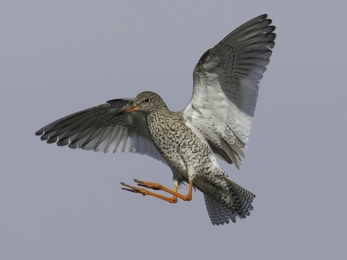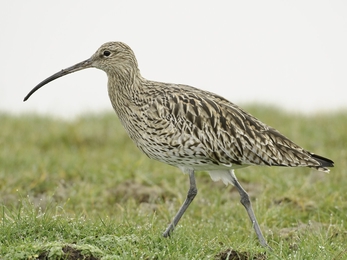Winter is the best time of year to spot waders, as birds from overseas swell our own population and swirling, probing and peeping gangs of these shoreline birds fill our estuaries, beaches and wetlands. Elegant and characterful, they’re a joy to watch – the only problem is that many of them look frustratingly similar. To make things a little easier, we’ve put together a short wader identification guide to some of the more common species you’re likely to spot.
How to tell the difference between similar wading birds
Dunlin by David Tipling/2020VISION
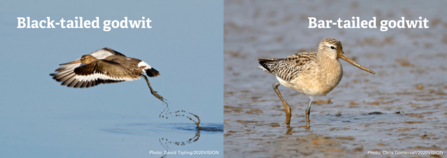
Black-tailed godwit and bar-tailed godwit
They’re two of our largest waders; they both have long bills for probing for worms and snails in the mud; and they both have long legs and necks. So how do you tell them apart?
Black-tailed godwit
- Very plain grey back and wings.
- When wings are raised, note the tail – strikingly black with a contrasting, square white rump.
- When raised, black wings display a huge, bold, white wing stripe.
- Very straight bill.
Bar-tailed godwit
- Heavily patterned grey back and wings, with streaking over the head, chest and neck in particular.
- When wings are raised you’ll see fine, even bars on the upperside of the tail. White rump extends over the back, forming a V-shape under the wings.
- When raised, wings are all dark brown and don’t have the white bar of the black-tailed godwit.
- Slightly upturned bill.
It’s a joy to watch these pretty waders poking around in the mud for their dinner, but they’re usually so busy feeding it’s difficult to spot them with their wings open. If they’re staying firmly rooted to the ground, use their back colour as an indicator of the species or bear in mind that black-tailed godwits are the more common of the two birds. Bar-tailed godwits are also the stouter and less lanky of the two.
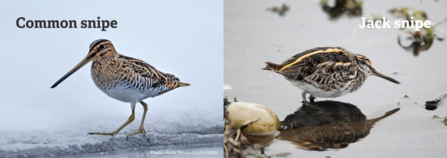
Common snipe and jack snipe
Both of these birds have ‘cryptic’ camouflage, which means their markings help them to blend in with their environment. This usually means upland vegetation, but in winter our snipe population is joined by birds from Scandinavia and they spread out along various wetland habitats, including coastal marshes. The jack snipe is the rarer of these two small waders but is seen along the Heysham coast fairly regularly. Here are some wader identification tips for snipe.
Common snipe
- An almost ludicrously long bill.
- Pale underneath and brown above, with creamy yellow stripes down the back.
- Stripy head, with dark stripes through the eyes. Pale central crown stripe.
- Holds body still when feeding.
Jack snipe
- Shorter bill than the common snipe.
- Pale underneath and brown above, with straw-yellow stripes down the back. These really contrast with the darker back which, in good light, has a beautiful green sheen.
- Stripy head, though the pattern of the stripes is different in the jack snipe. Dark central crown stripe.
- Body bobs up and down when feeding.
Of both snipe species, the jack snipe is the shorter of the two. Jack snipe are also more secretive and avoid feeding out in the open if they can. You’ll often be able to get a good look at a feeding common snipe.
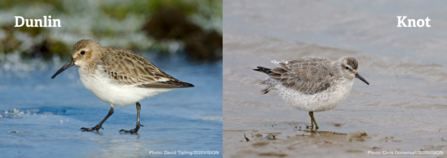
Dunlin and knot
This is where things get a little more complicated. A number of wading birds and shoreline birds look very similar to dunlin, so we’ll concentrate on knot as a comparison, as one of the more common waders you’ll encounter in our region.
Dunlin
- Smallish, with a body-size similar to a starling.
- Relatively long, slightly downcurved beak.
- Black legs.
- Plain grey above with clean white bellies. Small amount of grey on the sides of the chest that forms a very weak breast-band.
- Soft, plain head with no strong markings.
- In flight, dunlin display weak white wingbars, and a white rump with an obvious black central stripe running from the back to the central tail feathers.
Knot
- Larger than dunlin – body-size similar to a blackbird.
- Relatively short, straight beak.
- Murky grey-green legs. These are short and stumpy, and knot look quite out of proportion in general, with a heavy body and short neck.
- Plain silvery grey above, with a white belly and grey breast-band.
- Grey head with an indistinct white eye-stripe. Dark feathering between the eye and the bill.
- In flight, the knots dark outer wing contrasts with the paler inner wing. Their rump appears grey and doesn’t contrast with the back or tail.
Sometimes you might encounter sanderlings amongst knot or dunlin, but their unique feeding behaviour is a dead giveaway. Sanderlings run quickly along the edge of the surf on beaches, picking morsels from the surface as they go, and then scamper even faster back up the beach when the waves roll back in. No other British wader feeds like this.
Other common UK wading birds to spot
Thankfully our region is home to lots of other wading birds that are much easier to identify. Redshank, for example, have a grey body but can be easily distinguished by their red-orange bill and legs. Oystercatchers are unmistakeable: black and white with pink legs, a bright orange bill and striking red eyes. Curlews might be grey-brown but are impressively large, with a very long, obviously down-curved bill and quite possibly the most evocative call in the bird world, which you can hear below.
Then, of course, there is the lapwing. These birds can be identified on the ground by their white bellies and dark backs, which have a gorgeous petrol sheen in the sunshine. They also have long crest feathers that blow comically about in the wind. In the air you’ll see their long, paddle-shaped wings in all their glory.
We hope this introduction to wader identification has helped you feel a little more confident when it comes to distinguishing between some of the more common (and confusing) birds. Watching their busy flocks is a true winter wildlife highlight, and once you know what to look for, you may even spy a rarer visitor feeding amongst the group.
Where to watch wading birds in Lancashire and North Merseyside
- Barnaby’s Sands and Burrows Marsh
- Brockholes Nature Reserve
- Middleton Nature Reserve
- Heysham harbour
- Lunt Meadows
- Seaforth Nature Reserve
- The Mersey Estuary
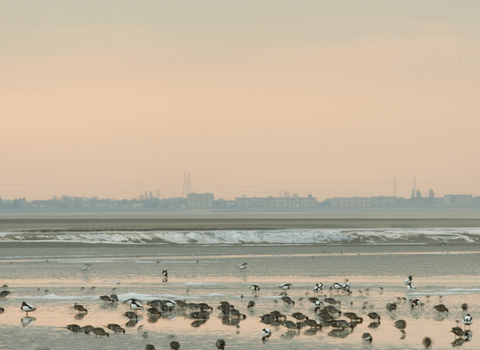
Help us keep our region special for waders
We're lucky to have so many wader wonderlands on our doorstep, but the coastlines and wetlands where these birds take refuge are under threat from development, pollution and climate change.
You can help us protect them.
By becoming a Wildlife Trust member you'll be directly funding our conservation work to boost wader numbers, protect and restore wading bird habitat, and lobby Government for legislative changes that will ensure a Wilder Future.


